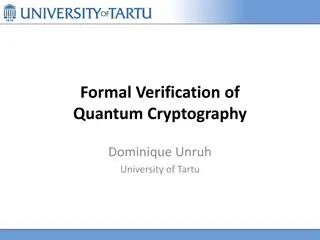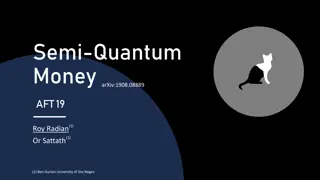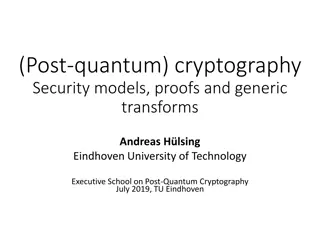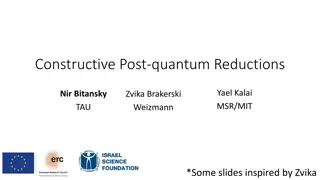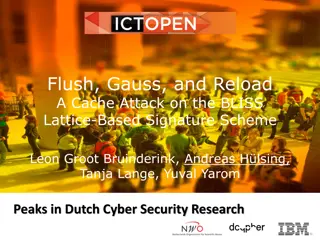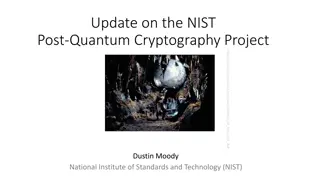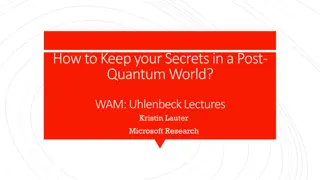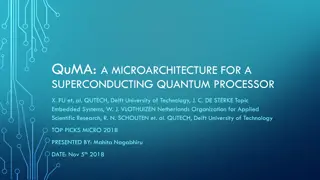Post-Quantum Cryptography in IEEE 802.11 - Current State and Future Concerns
Submission discusses the potential impact of post-quantum algorithms on IEEE 802.11 networks, highlighting the necessity to prepare for a post-quantum future. It explores the risks posed by quantum computing to existing cryptographic systems and emphasizes the importance of adopting post-quantum solutions. The document provides insights into NIST's PQ algorithm competition, finalists for key exchange and signature algorithms, and the Module-Lattice-based Key-Encapsulation Mechanism (ML-KEM) for establishing shared secrets securely.
Download Presentation

Please find below an Image/Link to download the presentation.
The content on the website is provided AS IS for your information and personal use only. It may not be sold, licensed, or shared on other websites without obtaining consent from the author.If you encounter any issues during the download, it is possible that the publisher has removed the file from their server.
You are allowed to download the files provided on this website for personal or commercial use, subject to the condition that they are used lawfully. All files are the property of their respective owners.
The content on the website is provided AS IS for your information and personal use only. It may not be sold, licensed, or shared on other websites without obtaining consent from the author.
E N D
Presentation Transcript
July 2024 doc.: IEEE 802.11-24/1103r0 Post-Quantum 802.11 Date: 2024-07-16 Authors: Name Dan Harkins Affiliations Address HPE Phone email Submission Slide 1 Dan Harkins, HPE
July 2024 doc.: IEEE 802.11-24/1103r0 Abstract This submission discusses current state of Post-Quantum algorithms and what their use in 802.11 might look like. It is not proposing any work right now in 802.11 nor is it proposing any groups be formed at this time to work on the topic. Just food for thought . Submission Slide 2 Dan Harkins, HPE
July 2024 doc.: IEEE 802.11-24/1103r0 Post-Quantum Cryptography Today all of our public key crypto is based on two hard problems: Factoring large numbers Discrete logarithm problem Our secure systems would become insecure if one (or both) of those were broken A quantum computer, which does not exist yet, will be able to break both of these Such a computer will exist in the (very near) future We need to plan for a post-quantum future with 802.11 Submission Slide 3 Dan Harkins, HPE
July 2024 doc.: IEEE 802.11-24/1103r0 Mosca Theorum There is a 1 in 7 chance that some fundamental public-key crypto will be broken by quantum by 2026, and a 1 in 2 chance of the same by 2031. Dr. Michele Mosca, (April 2015) If encrypted data needs to be safe for X years; and, If it takes Y years to deploy a post-quantum solution; and, If a post-quantum computer will exist in Z years Then if (X + Y) > Z you need to worry time Y X Z Submission Slide 4 Dan Harkins, HPE
July 2024 doc.: IEEE 802.11-24/1103r0 Current State of PQ Algorithms NIST held a nearly decade long, multi-round competition for PQ algorithms Separate tracts for key exchange, and signature algorithms Characteristics considered included (not exclusively): Efficiency in hardware and software Memory requirements Ease of implementation Finalists announced in 2023 ( ready for 2024 ) CRYSTALS-Kyber (key establishment) covered in FIPS 203 CRYSTALS-Dilithium (signature) covered in FIPS 204 SPHINCS+ (signature) covered in FIPS 205 FALCON (signature) FIPS TBD Submission Slide 5 Dan Harkins, HPE
July 2024 doc.: IEEE 802.11-24/1103r0 Module-Lattice-based (ML) Key-Encapsulation Mechanism (KEM) A KEM is a set of algorithms constructed to allow for two parties to establish a shared secret over a public medium ML-KEM (FIPS 203) defines such a construct using Kyber s public key encryption algorithm and three hash functions Three parameter sets defined with increasing security ML-KEM-512 providing security strength of 128bits ML-KEM-768 providing security strength of 192bits ML-KEM-1024 providing security strength of 256bits Submission Slide 6 Dan Harkins, HPE
July 2024 doc.: IEEE 802.11-24/1103r0 ML-KEM Three Algorithms KeyGen() Key generation algorithm creates encapsulation key and decapsulation key Encaps() Encapsulation algorithm takes encapsulation key and produces ciphertext and a secret Decaps() Decapsulation algorithm takes decapsulation key and ciphertext and produces a secret Bob Alice KeyGen decapsulation key encapsulation key Encaps Decaps ciphertext Alice s copy of shared secret Bob s copy of shared secret Submission Slide 7 Dan Harkins, HPE
July 2024 doc.: IEEE 802.11-24/1103r0 ML-KEM Key establishment, sort of like Diffie-Hellman Two message exchange: 1. Alice generates her encapsulation key and sends it to Bob 2. Bob sends Alice ciphertext Both sides generate a secret Exchange is unauthenticated! ML-KEM does Implicit Rejection If Alice fails to properly decapsulate the ciphertext, Decaps() will return a bogus value, each side will then have different secrets Need to do a key-confirmation step to ensure success ML-KEM is intended to be treated as a black box KYBER public key encryption algorithm cannot be used stand-alone Construct uses Fujisaki and Okamoto (FO) transform to obtain IND-CCA security from weaker IND-CPA PKE algorithm Submission Slide 8 Dan Harkins, HPE
July 2024 doc.: IEEE 802.11-24/1103r0 Using ML-KEM in 802.11 What 802.11 authentication protocols can use ML-KEM? EAP-TLS let the IETF deal with that FILS does asymmetric key agreement today STA sends Diffie-Hellman exponential (802.11 auth request) AP sends Diffie-Hellman exponential (802.11 auth response) ML-KEM-FILS! STA sends its encapsulation key (802.11 auth request) AP sends ciphertext (802.11 auth response) Algorithm Encaps key Decaps key ML-KEM-512 800 1632 ML-KEM-768 1184 2400 ML-KEM-1024 1568 3168 ciphertext 768 1088 1568 shared secret 32 32 32 Submission Slide 9 Dan Harkins, HPE
July 2024 doc.: IEEE 802.11-24/1103r0 FILS Authentication Signatures exchanged in assoc req/resp DILITHIUM signatures are too big! Algorithm ML-DSA-44 ML-DSA-65 ML-DSA-87 Public key 1312 1952 2592 Signature Size 2420 3293 4595 SPHINCS+ is bigger FALCON signatures would fit in an MSDU! Algoritm FALCON-512 FALCON-1024 Public Key 897 1793 Signature Size 618 1234 Submission Slide 10 Dan Harkins, HPE
July 2024 doc.: IEEE 802.11-24/1103r0 ML-KEM-FILS Using ML-KEM in 802.11 authentication req/resp Using FALCON in 802.11 association req/resp But how to pass FALCON public key? Certificate has ASN.1 goo, identity, public key, extra attributes, issuer signature Certificate + signature in association frame might be too much We could extend FILS to a 6 message exchange: ML-KEM in auth frames 1 and 2 Certificate exchange* in auth frames 3 and 4 Signature authentication in association frames Fragmentation/reassembly of 802.11 assoc frames? * Could be privacy protected using secret derived from ML-KEM exchange Submission Slide 11 Dan Harkins, HPE
July 2024 doc.: IEEE 802.11-24/1103r0 Authentication without Signatures Assuming Alice and Bob have long-term encapsulation keys Alice and Bob can trust each others encapsulation keys somehow Run ML-KEM twice: Alice uses Bob s key in Encaps() to him, Bob uses Alice s key in Encaps() to her Both secrets are bound to the transmitted ciphertexts in a KDF to produce a single shared secret This is analogous to the encrypted nonce method of authentication in IKEv1 (RFC 2409) Completely deniable! Let s call it The Bart Exchange I didn t do it. Nobody saw me do it. You can t prove anything -- Bart Simpson Submission Slide 12 Dan Harkins, HPE
July 2024 doc.: IEEE 802.11-24/1103r0 Authentication without Signatures Alice Bob Alice KeyGen Bob KeyGen decapsulation key encapsulation key decapsulation key encapsulation key Encaps ciphertext, C1 Decaps Decaps ciphertext, C2 Encaps Alice s copy of K2 Bob s copy of K1 Bob s copy of K2 Alice s copy of K1 K = HKDF-Expand(K1 | K2, C1 | C2) K = HKDF-Expand(K1 | K2, C1 | C2) Submission Slide 13 Dan Harkins, HPE
July 2024 doc.: IEEE 802.11-24/1103r0 Authentication without Signatures Two-message exchange authenticates peer and key! Resulting shared secret is bound to both ML-KEM invocations as well as the ciphertext transcript Then a two-message proof-of-possession exchange Simple auth+assoc exchange like current FILS How to signal which key to use? AP advertises (a hash of) its encapsulation key in beacons STA sends (a hash of) its encapsulation key along with the ciphertext in first message protected with secret from ML-KEM? But how to perform the out-of-band portion? Manual configuration? Certified encapsulation keys obtained somehow? QR code? Submission Slide 14 Dan Harkins, HPE
July 2024 doc.: IEEE 802.11-24/1103r0 QR code of ML-KEM encaps keys ML-KEM-768 ML-KEM-512 Note: they are base64-encoded Submission Slide 15 Dan Harkins, HPE
July 2024 doc.: IEEE 802.11-24/1103r0 Other Potential PQ 802.11 Protocols? There are several public key-based algorithms in 802.11, not all of them are suitable for PQ though SAE? Nope Dragonfly algorithm is not replaceable by PQ algorithm ML-KEM as a black-box cannot support a PAKE OWE? ML-KEM could replace Diffie-Hellman STA sends encapsulation key in associate request AP sends ciphertext in associate response AP PeerKey? Same as OWE . But do we need a PQ OWE (or PeerKey)? FILS, yes; others Submission Slide 16 Dan Harkins, HPE
July 2024 doc.: IEEE 802.11-24/1103r0 Summary A quantum computer would be able to break all the key agreement and signatures we do today FILS, SAE, OWE, all EAP methods including EAP-TLS. What protocols do we need to modify? 802.11 is a transient medium but how long do we want to protect our messages from exposure? How long will it take to deploy a solution?!? Remember Mosca Theorum: If (X+Y)>Z then Trouble! We need to think about what to do to be ready for a post-quantum world It s 2024 so the ready for 2024 algorithms are ready Submission Slide 17 Dan Harkins, HPE
July 2024 doc.: IEEE 802.11-24/1103r0 References FIPS 203-- https://nvlpubs.nist.gov/nistpubs/FIPS/NIST.FIPS.203.ipd.pdf Submission Slide 18 Dan Harkins, HPE
July 2024 doc.: IEEE 802.11-24/1103r0 Submission Slide 19 Dan Harkins, HPE





